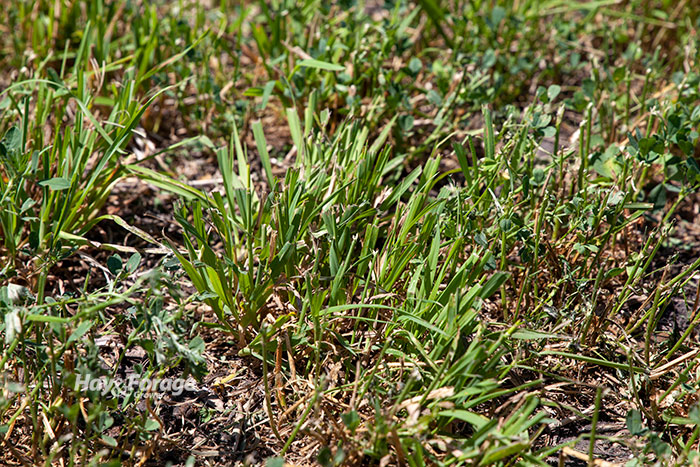There are consequences for cutting too low |
| By Amber Friedrichsen, Associate Editor |
|
|
 There are a lot of balls in the air when it comes to managing forage for stand longevity. Plant diseases, weed pressure, and weather are inevitable interferences, but cutting height, which also impacts persistence, is completely in a producer’s control. Adjusting mowers correctly is essential to ensure plants have enough energy to regrow and realize maximum productivity. Amanda Grev, forage and pasture specialist with University of Maryland Extension, explains that compared to sickle bar mowers, disc mowers can cut forages closer to the ground. Although this may bolster yields, plants will experience negative repercussions. Shorter stand longevity. To grow back after harvest, forages rely on two sources of energy: photosynthesis and reserved carbohydrates. Since photosynthesis occurs in the chloroplasts of leaf cells, there must be leaves remaining on plants to facilitate the regrowth process. This is especially important for grasses. Grev says when plants are cut too low, fewer leaves are present, which limits how much energy is generated from photosynthesis. Reserved carbohydrates are stored low in plants, either in the roots of legumes or in the base of stems and tillers in grass species. If grasses are mowed below their growing points, plants become stressed and produce less yield in future cuttings. Furthermore, continuing this malpractice could cause other issues. “A forage stand that has repeatedly been mowed short and is under stress will not only be slower to regrow, but it will be much more susceptible to other stressors like hot temperatures and potential drought,” Grev says. “A short cutting height also exposes more soils to the sun, increasing soil temperature, decreasing soil moisture retention, and providing opportunities for weeds or undesirable species to fill in.” Reduced forage quality. Forage quality can also suffer from cutting forages too short. The top portions of plants contain the highest levels of digestible nutrients, and stems are high in fiber and offer reduced feed value. Therefore, the lower forage is cut, the more fibrous material will be incorporated in the harvested crop. “Whether you are doing custom work or baling hay for your own use, quality should be as important as quantity,” Grev asserts. “Small differences in forage quality and digestibility can translate to large improvements in animal production, and a timely harvest and appropriate cutting height can play a large role in achieving greater forage quality.” With that said, Grev suggests a high cutting height might not hurt yield as much as it seems. According to a study from the University of Wisconsin-Madison, every additional inch of forage harvested from a field only resulted in about 0.13 tons per acre over the course of a three-cut season. She notes forage quality demonstrates a more dramatic decline when cut height is lowered, so the amount of yield gained must be weighed against how much quality is lost. More ash. Another consequence of mowing too close to the ground is elevated ash content. Harvested forages naturally contain 6% to 8% ash, but this value can rise to 18% when cut height is extremely low. Ash is primarily made up of silica and does not offer any nutritional value to animals, and Grev says each additional percentage of ash reduces total digestible nutrients by 1%. Grev recommends cutting cool-season grasses at or above 4 inches, whereas legumes can be cut to 2 to 3 inches. Manage for the dominant species in mixed stands. In other words, if legumes are the major stand component, a cutting height at 3 inches will maximize their yield and quality significantly without harming the grass species that are present. Conversely, if cool-season grasses make up the base, raise the cutting height to 4 inches to safeguard regrowth. Warm-season grasses such as sudangrass, sorghum-sudangrass, and millet are similar to cool-season grasses in that they store energy reserves in their stems and tillers; however, their growing points are found farther up in the plant, so these species must not be cut below 6 inches. “Keep in mind that these are all minimum recommendations — it is never a bad thing to mow at a higher height,” Grev states. “Next time you start up the mower, pay attention to the cutting height of your crop and don’t be afraid to leave a little extra plant material in the field,” she concludes.  Amber Friedrichsen |
